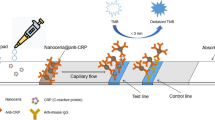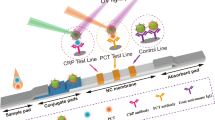Abstract
The construction of highly sensitive and specific immunosensing nanolabels have attracted tremendous attention in the development of reliable point-of-care disease diagnostics. However, there are still challenges with traditional immunoassays, such as complicated and time-consuming procedure, the use of enzyme label, non-specificity, and require readers for detection. Therefore, we have designed and developed site-directed antibody-immobilized calix[4]arene-gold nanoconjugate based colorimetric immunosensing nanolabel to offer high sensitivity. The prepared nanolabel enabled oriented binding of the antibodies by providing full accessibility of Fab domain for antigen binding. The improved sensitivity of the developed nanolabel was evaluated using vertical flow immunoassay (VFIA) for detecting C-reactive protein (CRP) with a lower detection limit up to 1 ng/ml. Our developed nanolabel was found to be highly specific, easy, quick, and appropriate for onsite detection. The nanolabel is validated with spiked blood samples which exhibited ~90% recovery having a relative error of ~2%. Furthermore, the nanolabel was also used for screening of human blood real samples which showed relative error of ~0.6%. The developed nanolabel can be utilized as a potential nanolabel for the quantitative detection of various biomolecules in clinical samples.
Graphical Abstract









Similar content being viewed by others
References
A. Amiri, E.Y. Choi, H.J. Kim, Development and molecular recognition of Calixcrownchip as an electrochemical ALT immunosensor. J. Incl. Phenom. Macrocycl. Chem. 66, 185–194 (2010)
G. Barbillon, J.-L. Bijeon, J. Plain, M.L. de la Chapelle, P.-M. Adam, P. Royer, Biological and chemical gold nanosensors based on localized surface plasmon resonance. Gold. Bull. 40, 240–244 (2007)
K. Bonroy, F. Frederix, G. Reekmans, E. Dewolf, R. De Palma, G. Borghs, P. Declerck, B. Goddeeris, Comparison of random and oriented immobilisation of antibody fragments on mixed self-assembled monolayers. J. Immunol. Methods. 312, 167–181 (2006)
J.P. Buttress, D.P. Day, J.M. Courtney, E.J. Lawrence, D.L. Hughes, R.J. Blagg, A. Crossley, S.E. Matthews, C. Redshaw, P.C. Bulman Page, “Janus” calixarenes: double-sided molecular linkers for facile, multianchor point, multifunctional, surface modification. Langmuir. 32, 7806–7813 (2016)
H. Cui, B. Xu, Supramolecular medicine. Chem. Soc. Rev. 46, 6430–6432 (2017)
Y. Ding, Z. Tong, L. Jin, B. Ye, J. Zhou, Z. Sun, H. Yang, L. Hong, F. Huang, W. Wang, An NIR Discrete Metallacycle Constructed from Perylene Bisimide and Tetraphenylethylene Fluorophores for Imaging-Guided Cancer Radio-Chemotherapy. Adv. Mater. 34, 2106388 (2022)
E.S. Español, M.M. Villamil, Calixarenes: Generalities and their role in improving the solubility, biocompatibility, stability, bioavailability, detection, and transport of biomolecules. Biomolecules. 9, 90 (2019)
S. Gandhi, I. Banga, P.K. Maurya, S.A. Eremin, A gold nanoparticle-single-chain fragment variable antibody as an immunoprobe for rapid detection of morphine by dipstick. RSC. Adv. 8, 1511–1518 (2018)
S.K. Ghosh, T. Pal, Interparticle coupling effect on the surface plasmon resonance of gold nanoparticles: from theory to applications. Chem. Rev. 107, 4797–4862 (2007)
S. Gurunathan, J. Han, J.H. Park, J.-H. Kim, A green chemistry approach for synthesizing biocompatible gold nanoparticles. Nanoscale. Res. Lett. 9, 1–11 (2014)
Q. Hao, Y. Chen, Z. Huang, J.-F. Xu, Z. Sun, X. Zhang, Supramolecular chemotherapy: carboxylated pillar [6] arene for decreasing cytotoxicity of oxaliplatin to normal cells and improving its anticancer bioactivity against colorectal cancer. ACS. Appl. Mater. Interfaces. 10, 5365–5372 (2018)
J. Hu, M. Gao, Z. Wang, Y. Chen, Z. Song, H. Xu, Direct imaging of antigen–antibody binding by atomic force microscopy. Appl. Nanosci. 11, 293–300 (2021)
K.V. Joshi, B.K. Joshi, A. Pandya, P.G. Sutariya, S.K. Menon, Calixarene capped ZnS quantum dots as an optical nanoprobe for detection and determination of menadione. Analyst. 137, 4647–4650 (2012)
A. Kausaite-Minkstimiene, A. Ramanaviciene, J. Kirlyte, A. Ramanavicius, Comparative study of random and oriented antibody immobilization techniques on the binding capacity of immunosensor. Anal. Chem. 82, 6401–6408 (2010)
J.E. Lee, J.H. Seo, C.S. Kim, Y. Kwon, J.H. Ha, S.S. Choi, H.J. Cha, A comparative study on antibody immobilization strategies onto solid surface. Korean. J. Chem. Eng. 30, 1934–1938 (2013)
X.-M. Li, V. Paraschiv, J. Huskens, D.N. Reinhoudt, Sulfonic acid-functionalized gold nanoparticles: A colloid-bound catalyst for soft lithographic application on self-assembled monolayers. J. Am. Chem. Soc. 125, 4279–4284 (2003)
S. Lou, J.-Y. Ye, K.-Q. Li, A. Wu, A gold nanoparticle-based immunochromatographic assay: the influence of nanoparticulate size. Analyst. 137, 1174–1181 (2012)
B. Lu, M.R. Smyth, R. O’Kennedy, Tutorial review. Oriented immobilization of antibodies and its applications in immunoassays and immunosensors. Analyst. 121, 29R-32R (1996)
K. Modi, U. Panchal, S. Dey, C. Patel, A. Kongor, H.A. Pandya, V. Jain, Thiacalix [4] arene-tetra-(quinoline-8-sulfonate): a Sensitive and Selective Fluorescent Sensor for Co (II). J. Fluoresc. 26, 1729–1736 (2016)
S.B. Nimse, T. Kim, Biological applications of functionalized calixarenes. Chem. Soc. Rev. 42, 366–386 (2013)
N. Niranjan Dhanasekar, G. Ravindran Rahul, K. Badri Narayanan, G. Raman, N. Sakthivel, Green chemistry approach for the synthesis of gold nanoparticles using the fungus Alternaria sp. J. Microbiol. Biotechnol. 25, 1129–1135 (2015)
E.B. Noruzi, M. Molaparast, M. Zarei, B. Shaabani, Z. Kariminezhad, B. Ebadi, V. Shafiei-Irannejad, M. Rahimi, J. Pietrasik, Para-sulfonatocalix [n] arene-based biomaterials: Recent progress in pharmaceutical and biological applications. Eur. J. Med. Chem. 190, 112121 (2020)
S.W. Oh, J.D. Moon, H.J. Lim, S.Y. Park, T. Kim, J. Park, M.H. Han, M. Snyder, E.Y. Choi, Calixarene derivative as a tool for highly sensitive detection and oriented immobilization of proteins in a microarray format through noncovalent molecular interaction. FASEB. J. 19, 1335–1337 (2005)
C.M. Pandey, S. Augustine, S. Kumar, S. Kumar, S. Nara, S. Srivastava, B.D. Malhotra, Microfluidics based point-of-care diagnostics. Biotechnol. J. 13, 1700047 (2018)
A. Pandya, K.V. Joshi, N.R. Modi, S.K. Menon, Rapid colorimetric detection of sulfide using calix [4] arene modified gold nanoparticles as a probe. Sens. Actuators. B. Chem. 168, 54–61 (2012)
A. Pandya, P.G. Sutariya, A. Lodha, S.K. Menon, A novel calix [4] arene thiol functionalized silver nanoprobe for selective recognition of ferric ion with nanomolar sensitivity via DLS selectivity in human biological fluid. Nanoscale. 5, 2364–2371 (2013a)
A. Pandya, P.G. Sutariya, S.K. Menon, A non enzymatic glucose biosensor based on an ultrasensitive calix [4] arene functionalized boronic acid gold nanoprobe for sensing in human blood serum. Analyst. 138, 2483–2490 (2013b)
A. Pandya, H. Goswami, A. Lodha, P. Sutariya, Supramolecular Nanoassembly and its Potential, in Advanced Functional Materials. (John Wiley & Sons, Inc, 2015), pp. 367–398
A. Prajapati, N. Verma, A. Pandya, Highly sensitive vertical flow based point-of-care immunokit for rapid and early detection of human CRP as a cardiovascular risk factor. Biomed. Microdevice. 22, 1–10 (2020)
D. Quaglio, L. Mangiardi, G. Venditti, C. del Plato, F. Polli, F. Ghirga, G. Favero, M. Pierini, B. Botta, F. Mazzei, Site-directed antibody immobilization by Resorc [4] arene-based immunosensors. Chem. A. Eur. J. 26, 8400–8406 (2020)
D. Quaglio, F. Polli, C. del Plato, G. Cianfoni, C. Tortora, F. Mazzei, B. Botta, A. Calcaterra, F. Ghirga, Calixarene: a versatile scaffold for the development of highly sensitive biosensors. Supramol. Chem. 33, 345–369 (2021)
P. Rathinaraj, A.M. Al-Jumaily, Internalization: Acute apoptosis of breast cancer cells using herceptin-immobilized gold nanoparticles. Breast. Cancer. Targets. Ther. 7, 51 (2015)
Y. Ryu, Z. Jin, M.S. Kang, H.-S. Kim, Increase in the detection sensitivity of a lateral flow assay for a cardiac marker by oriented immobilization of antibody. BioChip. J. 5, 193 (2011)
E.P. Simão, G.J. Barbieri, C.A. Andrade, M.D. Oliveira, Biosensor Based on Cysteine Monolayer and Monoclonal Antibody for Specific Detection of Aflatoxin B 1 in Rice. J. Braz. Chem. Soc. 27, 1040–1047 (2016)
M. Soler, M.-C. Estevez, M. Alvarez, M.A. Otte, B. Sepulveda, L.M. Lechuga, Direct detection of protein biomarkers in human fluids using site-specific antibody immobilization strategies. Sensors. 14, 2239–2258 (2014)
P.G. Sutariya, A. Pandya, A. Lodha, S.K. Menon, Fluorescence switch on–off–on receptor constructed of quinoline allied calix [4] arene for selective recognition of Cu 2+ from blood serum and F− from industrial waste water. Analyst. 138, 2531–2535 (2013)
P.G. Sutariya, A. Pandya, A. Lodha, S.K. Menon, A simple and rapid creatinine sensing via DLS selectivity, using calix [4] arene thiol functionalized gold nanoparticles. Talanta. 147, 590–597 (2016)
R.A. Taheri, A.H. Rezayan, F. Rahimi, J. Mohammadnejad, M. Kamali, Development of an immunosensor using oriented immobilized anti-OmpW for sensitive detection of Vibrio cholerae by surface plasmon resonance. Biosens. Bioelectron. 86, 484–488 (2016)
A.K. Trilling, J. Beekwilder, H. Zuilhof, Antibody orientation on biosensor surfaces: a minireview. Analyst. 138, 1619–1627 (2013)
P. Varghese, T. Pradeep, A textbook of nanoscience and nanotechnology (Tata McGraw-Hill Education, 2003)
S.K. Vashist, J.H. Luong, Handbook of Immunoassay Technologies, in Enzyme-linked immunoassays. (Elsevier, 2018)
N. Verma, B.S. Tiwari, A. Pandya, Field Deployable Vertical Flow Based Immunodevice for Detection of Potato Virus Y in Potato Leaves. ACS. Agric. Sci. Technol. 1, 558–565 (2021)
M. Wang, Q. Li, E. Li, J. Liu, J. Zhou, F. Huang, Vapochromic Behaviors of A Solid-State Supramolecular Polymer Based on Exo-Wall Complexation of Perethylated Pillar [5] arene with 1, 2, 4, 5-Tetracyanobenzene. Angew. Chem. 133, 8196–8201 (2021)
Y. Xia, J. Si, Z. Li, Fabrication techniques for microfluidic paper-based analytical devices and their applications for biological testing: A review. Biosens. Bioelectron. 77, 774–789 (2016)
G. Yu, X. Chen, Host-Guest Chemistry in Supramolecular Theranostics. Theranostics. 9, 3041 (2019)
J. Zhou, G. Yu, F. Huang, Supramolecular chemotherapy based on host–guest molecular recognition: a novel strategy in the battle against cancer with a bright future. Chem. Soc. Rev. 46, 7021–7053 (2017)
J. Zhou, L. Rao, G. Yu, T.R. Cook, X. Chen, F. Huang, Supramolecular cancer nanotheranostics. Chem. Soc. Rev. 50, 2839–2891 (2021)
Acknowledgements
We gratefully acknowledge SERB, India under Young Scientist Start-up Grant (YSS/2015/000258) and Gujarat State Biotechnology Mission (GSBTM Project ID: AJJV48). NV’s fellowship is supported by Indian Council of Medical Research (5/3/8/5/ITR-F/2022-ITR).
Author information
Authors and Affiliations
Corresponding author
Ethics declarations
Conflicts of interest
There are no conflicts to declare.
Additional information
Publisher's note
Springer Nature remains neutral with regard to jurisdictional claims in published maps and institutional affiliations.
Rights and permissions
Springer Nature or its licensor (e.g. a society or other partner) holds exclusive rights to this article under a publishing agreement with the author(s) or other rightsholder(s); author self-archiving of the accepted manuscript version of this article is solely governed by the terms of such publishing agreement and applicable law.
About this article
Cite this article
Verma, N., Sutariya, P., Patel, T. et al. Tailored calix[4]arene-gold nanoconjugate as a ultra-sensitive immunosensing nanolabel. Biomed Microdevices 25, 1 (2023). https://doi.org/10.1007/s10544-022-00640-0
Accepted:
Published:
DOI: https://doi.org/10.1007/s10544-022-00640-0




